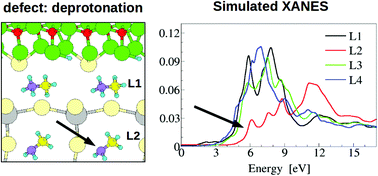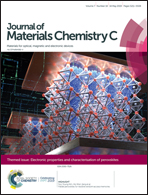Deprotonation and vacancies at the CH3NH3PbI3/ZnO and CH3NH3PbI3/GaN interfaces, detected in their theoretical XANES†
Abstract
MAPbI3 (MA = methylammonium, CH3NH3) perovskite solar cells are efficient but not stable. Some reasons for this fact originate from the interface effects, unsaturated bonds and defects. Four types of defects are studied: (i) dehydrogenated MA (CH3NH2), (ii) MA vacancies, (iii) halide vacancies, and (iv) Zn or Ga vacancies. X-ray absorption near-edge spectroscopy (XANES) is a sensitive tool for interface characterization when it is combined with computationally simulated spectra for specific atomic structures. This work shows how the simulated XANES of the MA N-core K-edge of MAPbI3 differ for various defected interfaces with the ZnO and GaN wurtzite crystals. Two polar orientations, (0001) and (000−1), of the semiconductors are chosen, and both surfaces are terminated with the metal atoms. Each defect leaves behind its unique fingerprint in their XANES. The most pronounced change in the spectrum is caused by the deprotonated MA, which is a product of the perovskite degradation due to moisture.

- This article is part of the themed collection: Electronic Properties and Characterisation of Perovskites


 Please wait while we load your content...
Please wait while we load your content...